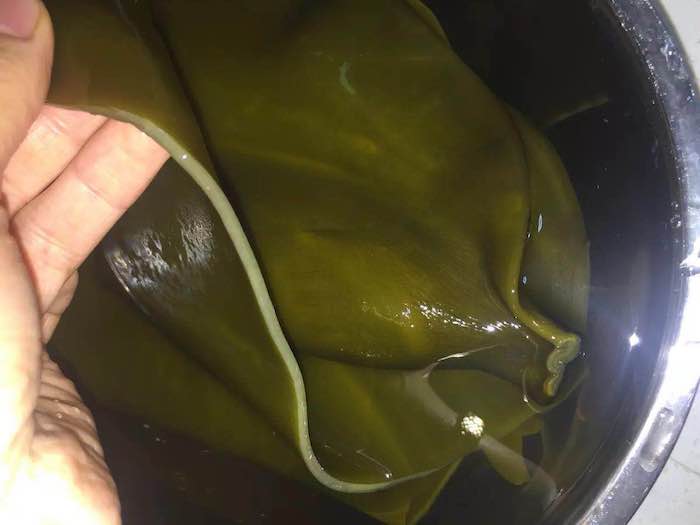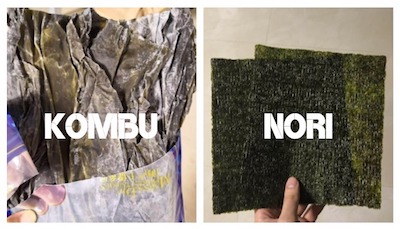We are reader supported. When you purchase through links on our site, we may earn an affiliate commission. Also, as an Amazon affiliate, we earn from qualifying purchases.

Sushi lovers are all too familiar with kombu and nori. To most, these are just vegetables that go down well with their favorite sushi. They don’t seem to differ by much. However, there are several fundamental differences between these two vegetables.
So, how does kombu differ from nori? The fundamental difference is that kombu is dried kelp while nori is a seaweed. However, the differences run deeper than that and involve factors such as nutrition, preparation, and usage, among others. Here is a deeper insight into how these two sea vegetables vary in every notable aspect.
Fundamental Differences between Kombu and Nori
Kombu and nori differ in a variety of factors ranging from appearance to their nutritional content. Both are staple Japanese dishes that are prepared and consumed in varying ways. However, both are consumed with sushi and a variety of other seafood – both can also be consumed independently. Here is an in-depth insight into how these two differ in:
Appearance and Texture

Kombu is sold while dry. It can be sold as whole sheets or in small pieces depending on your preferences. It is thick and has a dry texture that softens when immersed in water. It has a very dull color that is nearly black.
Nori like this is also sold while dry as whole sheets or pieces depending on your preference. It has a crispy texture and is lighter in color when compared to kombu. Its texture and flavor become ruined when immersed in water and hence should always be kept dry.
Nutrition
Kombu is rich in a range of nutrients including:
- Calcium
Kombu is rich in calcium that helps in the formation of strong bones and teeth. It is estimated that 10 grams of kombu provide as much as 17% of the required calcium intake. And, unlike most other sources of calcium, it is not allergic to calcium-intolerant individuals.
- Fiber
Kombu is rich in soluble fiber which is excellent for metabolism. Fiber aids in digestion and helps relieve problems such as constipation. It also supports good bowel movement and helps in weight loss.
- Iron
Kombu is also rich in iron and thus helpful in fighting anemia, which is on the rise. It’s iron content also helps overcome unexplained fatigue, dry nails, and shortage of breath for overall wellbeing.
- Minerals
Kombu is rich in a variety of minerals including zinc, magnesium, and germanium. These minerals have varying effects on the body but overall help boosts immunity, organ function, and muscle agility for overall wellbeing.
- Vitamins B, C, D, and E
Kombu is also rich in a variety of vitamins including vitamins B, C, D and E. Combined these vitamins contribute to the body’s overall wellbeing and prevent a variety of diseases.
Caution: Eating too much kombu can also cause hyperthyroidism as it is very rich in iodine.
Nori is also rich in a wide range of nutrients including:
- Proteins
Unlike kombu, nori is rich in soluble proteins that help with bodybuilding and repairing of torn body tissues.
- Vitamins
Nori is also rich in vitamins A and B1 which help boost eyesight and contribute to overall wellbeing by boosting the body’s natural immunity system.
- Zinc
Nori is also rich in a range of minerals especially zinc which helps repair damaged body tissues and contributes to the body’s overall wellbeing.
- Iron
Like kombu, nori is also rich in iron which is essentially to maintain and increase blood levels for overall wellbeing and energy production.
- Calcium
Nori is also rich in calcium which is good for the development of strong bones and teeth.
Source:https://en.wikipedia.org/wiki/Nori
Growing and Preservation
Japan is the biggest producer of Kombu albeit China has been covering the considerable ground. Kombu is harvested in Hokkaido’s shallow waters in Japan’s northern-most island. It is also farmed on a large scale in shallow waters off the shores of Japan as well as in modified farms off the shores of China. Once harvested, kombu is spread out in the sun to dry, cut into sheets of varying lengths and packed in plastic bags for sale. Kombu should be kept dry and only moisturized when being prepared for cooking and eating.
Again, Japan is also the largest producer of nori. It is harvested at sea and also farmed in modified farms across Japan and China – spores are planted on nets on January and then transferred to bays and lagoons. The seaweed is then harvested in autumn, washed in cold water and then spread out in the sun to dry. Once dry it is cut into sheets and packed in plastic bags – alternatively, it can be seasoned with mirin and soy sauce to make a variety of flavored versions of nori.
Preparation and Eating
Kombu has long been associated with good luck in Japanese culture. To this end, it is mostly served during the start of a new year as it is believed to bring good luck for the rest of the year. It can be cooked in a variety of ways. It is most popular for making dashi, a popular dish in Japan, by immersing it in boiled water. Kombu is also simmered in mirin, soy sauce, and a variety of other seasonings and added to boiled dishes to add flavor. It can also be softened in vinegar and shredded to make an olive-green dish known as tororo-kombu. Finally, it can be simmered and wrapped around herring and other fish to make kobu-maki.
Nori like this on Amazon is perhaps the more popular of the two as it is commonly used in sushi restaurants to wrap sushi and rice for a variety of dishes, in which cases it is called norimaki-zushi (see detailed review) – this does not necessitate any preparation and is done in its dry, natural state. It is also a popular breakfast snack when wrapped around rice and dipped in soy sauce. Finally, it can be shredded and added in a bowl of rice or doused in hot tea, in which case it is called O-chazuke.
Other Popular Types of Edible Sea Vegetables
Kombu and nori may be the most popular types of edible seaweeds, but there exist three other varieties that are just as nutritious:
- Wakame
Wakame, also known as sea mustard in the West, is just as popular in Japan as kombu and nori. It is highly nutritious and rich in nutrients such as iron, calcium, fiber, and a variety of vitamins. It grows in shallow water and is farmed today. It is harvested during spring and preserved by drying or salting it. It can be served raw in a salad or lightly simmered in soup. It can also be used as a garnish. It has a delicate taste and an aroma that resembles the sea. It is also crunchy unless when boiled for extended periods of time.
- Hijiki
Hijiki is also popular in Japan but not so much in the west. It is harvested and then dried in the sun. it expands by up to 10 times its size when immersed in water. It is used to make soup when simmered with soybeans, tofu, and a variety of other vegetables. It is nutritious and believed to contain a variety of minerals and vitamins although research into it is not as extensive. It has a sweet, delicate taste and crunchy texture.
- Kanten
Made from tengusa (a form of plant popular referred to as heavenly grass), kanten has striking similarities to gelatin except for the fact that it does not contain animal products. It is highly nutritious and rich in a range of minerals and vitamins. Once harvested it is dried for preservation purposes; it is very delicate when dried as it is thin enough to see through and even float in the air. Kanten is easy to prepare as it is simply soaked in water and poured in to soups and vegetables.
Related Questions
Is it true that kombu has cancer-healing properties?
Kombu has been taunted to contain properties that fight against cancer and other chronicle diseases. This is especially popular in Japan and China. However, these claims have not yet been verified and research is still ongoing. However, it does contain healing properties for a range of other minor conditions such as iron and calcium deficiency.
Does nori have any healing properties?
Nori, unlike kombu, has not been claimed to have any healing properties. However, its range of nutrients including vitamins and minerals to help prevent a wide range of diseases by improving the body’s immune system.
Are wild kombu and nori safe for eating?
Yes, wild kombu and nori are perfectly safe for eating. However, considering the rising levels of pollution in the sea, people are cautioned against eating too much of these seaweeds as they may absorb the pollutants. Some people are also concerned about the wellness of Japanese kombu and nori owing to the fukushima nuclear leak. To this end, it is advisable to buy your kombu or nori from certified merchants.



Comments
Pingback: Why Is My Nori So Chewy? [Options to Improving Your Seaweed] - Easy Homemade Sushi
Pingback: What Does Sushi Mean In Japanese? - Easy Homemade Sushi